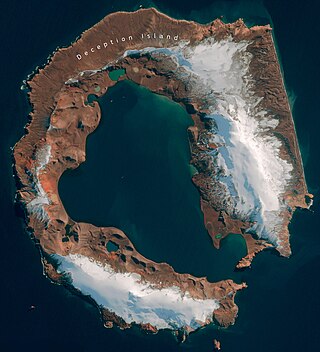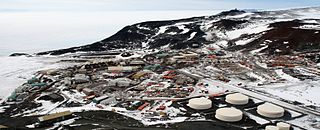
Deception Island is in the South Shetland Islands close to the Antarctic Peninsula with a large and usually "safe" natural harbor, which is occasionally affected by the underlying active volcano. This island is the caldera of an active volcano, which seriously damaged local scientific stations in 1967 and 1969. The island previously held a whaling station. It is now a tourist destination with over 15,000 visitors per year. Two research stations are operated by Argentina and Spain during the summer season. While various countries have asserted sovereignty, it is still administered under the Antarctic Treaty System.

McMurdo Station is an American Antarctic research station on the southern tip of Ross Island, which is in the New Zealand–claimed Ross Dependency on the shore of McMurdo Sound in Antarctica. It is operated by the United States through the United States Antarctic Program (USAP), a branch of the National Science Foundation. The station is the largest community in Antarctica, capable of supporting up to 1,500 residents, and serves as one of three year-round United States Antarctic science facilities. All personnel and cargo going to or coming from Amundsen–Scott South Pole Station first pass through McMurdo. McMurdo Station continues to operate as the hub for American activities on the Antarctic continent. By road, McMurdo is 3 kilometres (1.9 mi) from New Zealand's smaller Scott Base.

The South Shetland Islands are a group of Antarctic islands with a total area of 3,687 km2 (1,424 sq mi). They lie about 120 kilometres north of the Antarctic Peninsula, and between 430 and 900 km southwest of the nearest point of the South Orkney Islands. By the Antarctic Treaty of 1959, the islands' sovereignty is neither recognized nor disputed by the signatories and they are free for use by any signatory for non-military purposes.

Palmer Station is a United States research station in Antarctica located on Anvers Island, the only US station located north of the Antarctic Circle. Initial construction of the station finished in 1968. The station, like the other U.S. Antarctic stations, is operated by the United States Antarctic Program (USAP) of the National Science Foundation. The base is about as distant from the equator as Fairbanks, Alaska.

The McMurdo Sound is a sound in Antarctica, known as the southernmost navigable body of water in the world, located approximately 1,300 kilometres (810 mi) from the South Pole.

Livingston Island is an Antarctic island in the Southern Ocean, part of the South Shetlands Archipelago, a group of Antarctic islands north of the Antarctic Peninsula. It was the first land discovered south of 60° south latitude in 1819, a historic event that marked the end of a centuries-long pursuit of the mythical Terra Australis Incognita and the beginning of the exploration and utilization of real Antarctica. The name Livingston, although of unknown derivation, has been well established in international usage since the early 1820s.

The United States Antarctic Program is an organization of the United States government which has a presence in the Antarctica continent. Founded in 1959, the USAP manages all U.S. scientific research and related logistics in Antarctica as well as aboard ships in the Southern Ocean.

Nathaniel B. Palmer is an icebreaking research vessel (RVIB) owned by Offshore Service Vessels LLC, operated by Edison Chouest Offshore, Inc. and chartered by the United States National Science Foundation. Nathaniel B. Palmer is tasked with extended scientific missions in the Antarctic. Nathaniel B. Palmer was purpose-built for and delivered to the NSF by Edison Chouest Offshore's North American Shipbuilding facility in 1992. Nathaniel B. Palmer is able to support up to two helicopters, accommodates up to 45 science and technical personnel, has a crew of 22 and is capable of missions lasting up to 65 days. The vessel is named after merchant mariner and ship builder Nathaniel Brown Palmer, credited by some historians as the first American to see Antarctica.

Laurence McKinley Gould was an American geologist, educator, and polar explorer. He made expeditions to both the Arctic and Antarctic, and was chief scientist on Richard Evelyn Byrd's first Antarctic expedition, which Gould described in his 1931 book Cold: the Record of an Antarctic Sledge Journey. He served as president of Carleton College from 1945 to 1962, and president of the American Association for the Advancement of Science in 1964. His namesakes include the research vessel Laurence M. Gould as well as Antarctic features including Gould Bay, Gould Coast, and Mount Gould.
The British Antarctic Survey (BAS) is the United Kingdom's national polar research institute. It has a dual purpose, to conduct polar science, enabling better understanding of global issues, and to provide an active presence in the Antarctic on behalf of the UK. It is part of the Natural Environment Research Council (NERC). With over 400 staff, BAS takes an active role in Antarctic affairs, operating five research stations, one ship and five aircraft in both polar regions, as well as addressing key global and regional issues. This involves joint research projects with over 40 UK universities and more than 120 national and international collaborations.

The Chilean Antarctic Territory or Chilean Antarctica is a part of West Antarctica claimed by Chile. It comprises the region south of 60°S latitude and the area between longitudes 53°W and 90°W, partially overlapping with the Antarctic claims of Argentina and the United Kingdom. The Antártica commune is administered by the Cabo de Hornos municipality on the South American mainland.

The MS Explorer or MV Explorer was a Liberian-registered cruise ship, the first vessel of that kind used specifically to sail the icy waters of the Antarctic Ocean. She was the first cruise ship to sink there, after striking an iceberg on 23 November 2007. All passengers and crew were rescued.

The Byrd Station is a former research station established by the United States during the International Geophysical Year by U.S. Navy Seabees during Operation Deep Freeze II in West Antarctica.

The RV Polar Duke is a 219-foot ice-strengthened research vessel built in 1983. Polar Duke was designed specifically for scientific research with wet and dry laboratories, and an electronic workshop and laboratory. The hull is constructed similar to that of an icebreaker, but the ship isn’t as powerful as an icebreaker. It was originally equipped with a stern A-frame crane and helicopter deck; these were both removed in a major refit in 1998.

Edison Chouest Offshore (ECO), which started as Edison Chouest Boat Rentals in 1960, is family of companies in the marine transportation business based in Cut Off, Louisiana. ECO owns and operates a fleet of platform supply vessels, Subsea Construction / IMR vessels, a Riserless Light Well Intervention vessel, Anchor handling tug supply vessels, Oil Spill Response Vessels, and Well Stimulation Vessels, as well as an independently owned fleet of Research Vessels and Ice Breakers.
Mount Sutherland is a peak 1.4 nautical miles (2.6 km) west-northwest of the summit of Mount Terror on Ross Island. The feature rises to c.2500 m. Named by Advisory Committee on Antarctic Names (US-ACAN) (2000) after Alexander L. Sutherland, Jr., Ocean Projects Manager, OPP, National Science Foundation (NSF), with responsibility for directing operations and logistics for United States Antarctic Program (USAP) research vessels from 1989; responsible for acquisition of the Research Vessel/Ice Breakers Nathaniel B. Palmer and Laurence M. Gould.
Spillane Fjord is a fjord in front of Crane Glacier in the western part of Exasperation Inlet, Oscar II Coast in Graham Land, entered between Caution Point and Delusion Point. The feature is 2 miles wide, 10 miles long and averages 1000 m deep. Its greatest depth is 1250 m at the far west end of the fjord. The fjord was created by the catastrophic retreat of Crane Glacier, which was itself caused by the breakup of the north portion of the Larsen Ice Shelf in March, 2002. The fjord's creation was documented by satellite images and the feature was first visited by surface ship in April 2006 during the U.S. Antarctic Program NBP06-03 cruise, when the extent, depth and dimension were determined by swath bathymetry. Named by US-ACAN in 2007 after Joshua Spillane who served the USAP as a marine technician aboard L.M. Gould and N.B. Palmer. He lost his life in Drake Passage, April 16, 2006, while L.M. Gould was transiting from Palmer Station to Punta Arenas, Chile.
Deborah K. Steinberg is an American Antarctic biological oceanographer who works on interdisciplinary oceanographic research programs. Steinberg's research focuses on the role that zooplankton play in marine food webs and the global carbon cycle, and how these small drifting animals are affected by changes in climate.

RV Hero was a research vessel that operated in Antarctica for the National Science Foundation between 1968 and 1984. She was decommissioned in 1984 and partially sank in 2017 after a storm in Bay Center, Washington.
While crime in Antarctica is relatively rare, isolation and boredom affect certain people there negatively and may lead to crime. Alcoholism is a known problem on the continent, and has led to fights and indecent exposure. Other types of crimes that have occurred in Antarctica include illicit drug use, torturing and killing wildlife, racing motorbikes through environmentally sensitive areas, assault with a deadly weapon, attempted murder, and arson. Sexual harassment also has been reported.


















